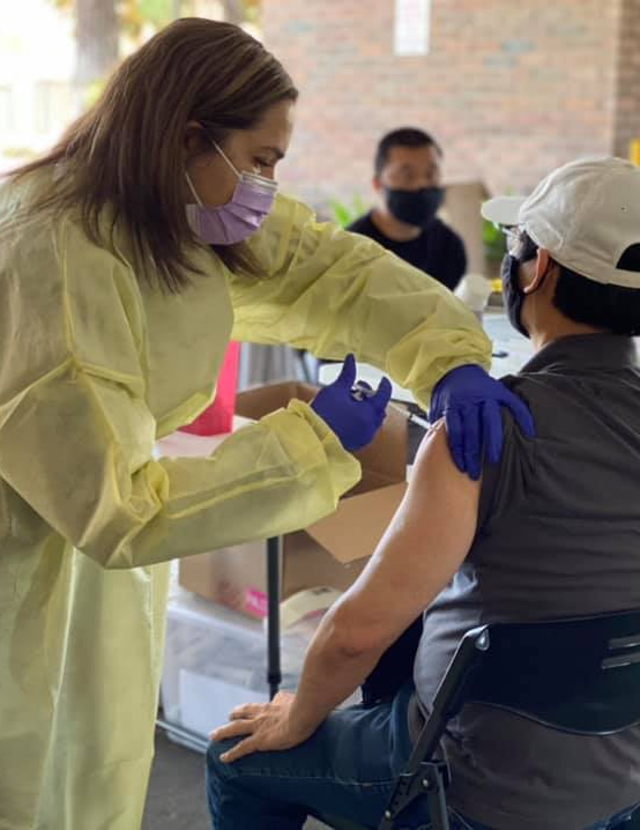Cutting-Edge Data for Equitable Distribution of Food, Shelter and Vaccines
Highlights

Throughout the COVID-19 pandemic PHI’s Public Health Alliance of Southern California worked closely with city and county health departments who used the Alliance's HPI tool to help allocate vaccines and prioritize vaccine appointments and provide essential social supports such as food and rent assistance.
$100M funds for housing assistance directed in part to areas identified by the HPI in San Diego County
-
Focus Areas
Communicable Disease Prevention -
Issues
Population Health -
Expertise
Public Policy Development -
Strategic Initiatives
COVID-19, Vaccine Access & Equity
PHI’s Public Health Alliance of Southern California works closely with city and county health departments and through the COVID-19 pandemic the Alliance was instrumental in providing data that cities and counties needed to direct resources and aid to under-resourced and disproportionately impacted communities. The Healthy Places Index (HPI), created by the Alliance in 2018, was an essential tool counties used to embed equity into their COVID response efforts and partner with local groups in neighborhoods with the greatest needs.
Across California, the pandemic hit hardest in low-income communities and communities of color that have faced historic and ongoing racism and the resulting inequities in social determinants of health that impact COVID-19 outcomes. Health officials in county health departments found the HPI especially valuable in their efforts to distribute COVID support and resources more equitably. Many health departments used it to prioritize COVID testing, vaccinations and outreach to communities most impacted by inequities, including:
Vaccine Allocation and Mobile Vaccination Sites
- Los Angeles County used the HPI to help inform the County’s plan to vaccinate communities hardest hit by the COVID-19 pandemic. Using HPI data the County identified where to reach out to community groups, add additional vaccination sites, understand mobile vaccination needs, and tailor informal and education strategies.
- Riverside County used HPI and other data to identify and prioritize vaccine allocation to disproportionately impacted communities and identify CBO partners for helping to vaccinate migrant farmworkers who have been among the most impacted communities.
- Orange County used the HPI to inform its Targeted Equity Investments (TEI) to support residents who experience the least healthy living conditions, contracting with CBOs to expand multilingual, culturally appropriate COVID testing, tracing, and health education.
- Santa Barbara County used HPI as a key indicator to direct pop-up COVID-19 testing sites to impacted neighborhoods where residents lack access to healthcare and other resources.
- Alameda County used the HPI in their vaccination plan to support siting of vaccination locations and insights on to help their community partners identify specific community needs. The County also used the HPI to identify five priority neighborhoods in its Targeted Equity Investments, designed to reduce inequities in COVID-19 transmission and promote an equitable recovery.
Prioritizing Vaccination Appointments
- Marin County used HPI data to prioritize vaccines for vulnerable groups disproportionately burdened by the pandemic and focused outreach to provide priority notification of available vaccine appointments to HPI tracts with the least healthy conditions and communities of color.
- Contra Costa County created an internal, interactive map with HPI, heat maps of vaccinations, and location of vaccination sites to aid prioritization and allocation decisions.

Our entire state has come together to redouble our efforts to reduce the devastating toll COVID-19 has had on our Latino, Black and Pacific Islander communities. This isn’t just a matter of higher cases in these communities – it is an issue of life and death that is hurting all Californians.Dr. Erica Pan, CDPH
Targeting Emergency Rental Assistance
- San Bernardino County used HPI data to focus the efforts of its Emergency Rental Assistance Program on hardest hit individuals and households.
- San Diego County’s COVID-19 Emergency Rental Assistance Program (ERAP) used HPI as part of its prioritization criteria, allocated $100M for this program in March 2021. Prioritization criteria include applicants who live in areas that fall within the bottom two quartiles of HPI. The County’s Department of Parks & Recreation also allocated $1.2 million for youth sports and camps focusing on the lowest HPI quartile, and their Office of Education used HPI as part of its COVID-19 School Reopening Guidance, to help identify and monitor the needs of its students placed at highest risk and embed equity into educational considerations.
Targeting Food Insecurity
- The City and County of San Francisco’s Feeding Unit used HPI to help map and analyze their response to COVID-19 including to help minimize hunger and protect disproportionately impacted residents from hunger.
- Monterey County developed its “VIDA Project,” helping families with food deliveries and connecting farmworkers struggling with food insecurity to food assistance resources, focusing on the lowest quartile of the HPI.
School Reopening
- In San Diego County, the Office of Education used HPI as part of its COVID-19 School Reopening Guidance, to help identify and monitor the needs of its students placed at highest risk and embed equity into educational considerations.
Across the state, counties found that, when coupled with authentic community engagement and partnership, the HPI was an essential tool for addressing race and place-based inequities that disproportionately impact communities of color and low-income people throughout the pandemic and beyond.
Work With Us
You change the world. We do the rest. Explore fiscal sponsorship at PHI.
Support Us
Together, we can accelerate our response to public health’s most critical issues.
Find Employment
Begin your career at the Public Health Institute.
